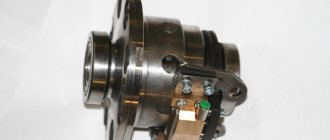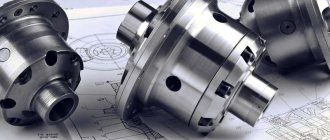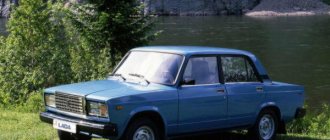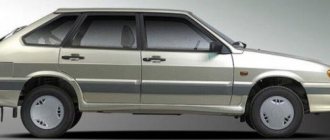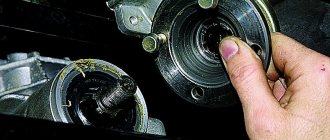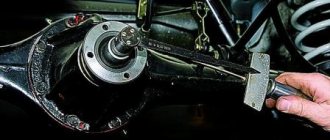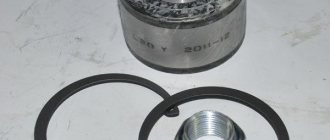Most new cars are equipped with a differential lock. Some of the older models also have this mechanism, but these are mainly SUVs and trucks. But today, every self-respecting manufacturer, for greater vehicle cross-country ability over rough terrain and in bad weather conditions, supplements the drive system with this mechanism.
As a rule, it is installed on the rear axle, but more and more often you can find cars with locking front and rear wheels. Electronic differential locking has become a fashion trend. The benefits of the system cannot be overestimated; it is not for nothing that many car enthusiasts install it on cars that were not originally equipped with the mechanism. To get excited about this idea, it is enough to experience the difference in driving with and without torque limitation. Or at least see how these cars will behave in difficult road conditions. But first, you should learn in more detail about what a differential lock is and what role it plays in the drive from the gearbox to the wheel axle.
WHAT IS DIFFERENTIAL
Not many drivers know that the right and left wheels travel different distances when driving. This phenomenon is due to the fact that when turning, the wheels rotate at different angles relative to the axle shaft. The outer one travels a greater distance when turning than the inner one. The differential distributes torque between both wheels depending on the movement of each of them. If one of the wheels for some reason stops turning, its load goes to the neighboring one.
The non-driving axles have no connection with each other, so the wheels rotate independently of each other. The axle shafts of the driving wheels are connected to each other. The drive is designed in such a way that one axle shaft and transmission can spin both wheels. On a flat road with good surface it is practically not felt. But on rough terrain, slippery or wet roads, the lack of a uniform torque distribution system makes itself known immediately. A non-locking differential rotates only the axle shaft that has the least resistance.
Roughly speaking, a differential is a unit unit that distributes torque to the wheels along the axle shafts.
DEVICE
The operating principle of the above-mentioned unit is the same, no matter where it is installed. The classic car differential is based on a planetary gear. The cardan shaft rotates the drive gear of the axle reducer. Its rotation is transmitted to the driven gear. And since it is attached to the differential housing, it moves with it. From the body, the torque is transmitted to the axle shafts using gears independent from each other, called satellites. The rotation speed of the propeller shaft is not equally divided between the axle shafts. However, for any ratio of speeds, their sum is always constant.
Types of blocking:
- automatic;
- forced, activated by the driver.
By blocking control method:
- mechanical;
- electromechanical;
- hydraulic;
- pneumatic
Differential purpose
When turning a car, wheels located closer to the center of curvature of the trajectory travel a shorter distance than those rotating in an outer arc. Their speeds are also different. And since a drive without a differential rotates both wheels of the same axle at the same speed, one of them begins to slip. This increases tread wear and worsens vehicle handling. The differential allows the drive wheels to rotate at different speeds.
As long as the drive axle is in good contact with the road, this device works flawlessly. But as soon as the road grip under one of the wheels deteriorates, for example, when it hits ice or liquid mud, only one of them will rotate. A wheel with a high coefficient of adhesion stops spinning and the car stops. If you lock the differential, this will not happen. Therefore, a locked differential improves the vehicle's maneuverability on difficult sections of the road.
If a car has one drive axle, then it also has one differential - between the wheels of this axle. A car with permanent 4-wheel drive has three. One between the wheels of each axle plus one between the axles.
Device
The operating principle of the above-mentioned unit is the same, no matter where it is installed. The classic car differential is based on a planetary gear. The cardan shaft rotates the drive gear of the axle reducer. Its rotation is transmitted to the driven gear. And since it is attached to the differential housing, it moves with it. From the body, the torque is transmitted to the axle shafts using gears independent from each other, called satellites. The rotation speed of the propeller shaft is not equally divided between the axle shafts. However, for any ratio of speeds, their sum is always constant.
- automatic;
- forced, activated by the driver.
By blocking control method:
- mechanical;
- electromechanical;
- hydraulic;
- pneumatic
Automatic differential lock
A self-locking differential is a mechanism that, under certain conditions, switches and, turning into a direct transmission, begins to divide the rotation speed of the driveshaft between the axle shafts equally. Differentials with automatic locking can lock themselves depending on the value of one of two parameters:
- differences in angular velocities of the axle shafts. This group includes differentials with disc locking, cam, viscous coupling and operating according to the Ferguson formula;
- torque transmitted to the axle shafts.
Types of mechanisms
There are two main types of self-locking differentials, which include several more subtypes. The first type is devices that lock depending on the angular velocities on the vehicle axles. They can be:
- disk;
- with viscous coupling;
- with electronic locking.
The second type is mechanisms that lock depending on the torques on the axes. These include worm differentials.
There are also center and cross-axle differentials. They involve the distribution of torque between the axles and wheels, respectively. Depending on the moment of distribution attributable to the axles or wheels, symmetrical and asymmetrical types of mechanisms are distinguished. On vehicles called all-wheel drive, three types of differentials are installed at once: two of them are interwheel, and one is interaxle.
On the Niva it is possible to install electronic, mechanical (it is a conventional mechanism combined with a viscous coupling), and pneumatic differentials.
The electronic self-block has a very big advantage. To use it, just press a button. It works in automatic mode, but only when the car is traveling at a certain speed, which is below a threshold value. The system turns off when the speed exceeds the set speed.
The pneumatic differential is a mechanism mounted on two axles. The advantage is compactness. In its work it uses pneumatic systems.
The mechanical self-block is the simplest in its design; it is cheaper than pneumatic and electronic devices. The mechanism consists of two semi-axial and two spacer couplings, pins and springs. Quite a reliable design, despite its simplicity.
How to do
The easiest way is to permanently lock the differential completely. But such a homemade blocking is acceptable for cars driving only off-road. For example, for rally-raid cars. To implement the idea, you need to remove the unit equipped with the differential and disassemble it. Then weld the satellites to the axles. Fixing the gears will allow the mechanism to divide the rotation speed between the axle shafts only in a ratio of 50 to 50. Making a limited slip differential with your own hands is a little more difficult than simply fixing the satellites. But such a modernization will not only improve the vehicle’s maneuverability in mud and snow, but will also not change the operation of the unit on hard surfaces. One version of such a device can be assembled from two brass or bronze bushings and a spring. Their sizes will depend on which vehicle transmission you are upgrading. Therefore, work begins with removing the assembly and disassembling the planetary gear. After this, you can take measurements, order the production of bushings and select a spring of suitable dimensions.
You will find out whether it is stiff enough after assembly by testing your homemade product. The spring is designed to press the pinion gears against the differential housing. Because of this, under the influence of friction, the satellites will rotate more slowly around their axis. The greater the friction force, the more evenly the speed of rotation of the driveshaft will be divided between the axle shafts. Metal bushings are needed to prevent contact of the satellites with the spring.
Of course, installing a factory-made differential lock is easier and the result of such an upgrade is better. However, it is expensive and practically eliminates creativity from the process. The cost of “self-blocks” for cars of the VAZ family is slightly less than 12 thousand rubles. But their installation requires only care and accuracy. There is no need for a special tool.
Which lock is better?
The answer to this question depends on what kind of car you have and where you drive it. Therefore, let’s say just a few words about the features of different types of blocking.
- Forced manual locking. The advantage is that it is completely turned on and off at the right time and, as a result, better cross-country ability of the vehicle. The disadvantages include the need for advance switching on and mandatory switching off.
- Automatic blocking. Switching on and off without driver intervention is a definite advantage. Noticeable inertia is its obvious drawback.
DIY self-block installation instructions
To install a self-locking differential on a Niva, it is not necessary to contact a car service center. It is quite possible to do this with your own hands, provided that the person has a good understanding of the structure of the car. The type of differential and its installation location are not particularly important.
First you need to decide on the place where the work will be done; it should be spacious enough. Using several jacks, you will need to lift the Niva, dismantle the wheels, then drain the engine oil from the gearbox housing into some container and remove the drive axle drive. To do this, just use a spanner to unscrew all the nuts securing the front cover to the gearbox housing, remove the cover and gasket.
Now it is necessary to reliably and efficiently carry out the operation of dismantling the axle shafts, which is very difficult to do without a special puller. The metal is clamped on rotary slots, which requires a lot of effort, which not every person has enough. Dismantling the axle shafts is carried out as follows:
- Unscrew all the bolt nuts on the axle bearing mounting plate.
- The brake mechanism is fixed. This can be done using bolts or wire. If the mechanism is not secured, the brake lines may come off.
- The axle shaft itself is removed. With sufficient skill, this can be done by hand, but it is better with the help of a puller.
Then you need to change the bearings. This will require a hydraulic press. It will help ensure that the holder fits onto the shaft, and with fairly high accuracy. To replace you need:
- Unscrew the hub bearing nut and remove the bushing. Unscrew the nut securing the lever to the steering knuckle.
- Remove the locking plate and unscrew the lever from the steering knuckle.
- Having disconnected all the fasteners, separate the knuckle and the hub with the brake disc. Remove the bearing by first holding the steering knuckle in a vice. During assembly, the bearing is put on using a press.
After the clearances in the main gear are adjusted using special washers of variable thickness, you can begin assembling the unit. Adjusting the gaps is quite difficult, and you will need special equipment, but to ensure accuracy you can use a steelyard. To work with it, wind one end of a 1 m long cord around the flange and secure the other end to the scales. By pulling the device in the winding, you will need to record the turning moment.
To ensure proper operation of the gearbox, the parts are usually sealed before the halves are assembled. In its absence, malfunctions may occur during operation, as well as failure of certain spare parts. After applying the sealant, you need to wait a while for it to harden. Then new oil should be poured into the gear housing. All sealing joints that were damaged during dismantling, as well as those that show signs of oil leakage, must be completely replaced with new ones. Now you can start assembling all the mechanisms in reverse order.
After completing all the replacement and installation of parts, you must check the operation of the devices that provide vehicle braking. Their malfunction may affect road safety.
The feasibility of such an action as differential locking on a Niva depends on why the driver needs it. If you need to move through difficult areas, you will need it. If a car enthusiast intends to drive on a normal asphalt road, then installing a self-locking differential on the Niva is hardly worth it. Which self-block to choose and where to place it depends on the driver’s preferences.
If desired, you can lock the differential with your own hands in the drive axle gearbox of any car. A driver who uses his car exclusively on paved roads will most likely never have the desire to lock the differential. Another thing is for those who like to conquer off-road terrain.
Free differential
First, let's clarify what a free differential is.
Free means he is not burdened with anything, which means he has no systems that affect his work.
Such a differential does not transfer torque to the other when one wheel slips. Driving a car in difficult conditions with such a differential is very difficult.
To increase the vehicle's cross-country ability, that is, to equalize the torque on both wheels, a differential lock is needed.
To put it specifically, in technical language, to fasten the differential housing to one of the axle shafts, or to block or impede the rotation of the satellites.
diff
If you want to improve the cross-country ability of a single-wheel drive car, then a self-locking differential (at least with a slight interference fit) is not the best solution.
The marginal improvement in all-terrain performance is not worth the investment. If you want to improve the cross-country ability of a single-wheel drive car, then a self-locking differential (at least with a slight interference fit) is not the best solution. The marginal improvement in all-terrain performance is not worth the investment. Let’s supplement the subjective sensations with those experienced on light off-road conditions. The site was chosen to be ideal: as you move forward, the surface under the wheels gets worse. We passed a place where a car with a loose differential had recently gotten stuck. However, with the blocking, she moved only a little further. Toothy tires and especially snow chains would have given no less confidence.
What is a differential lock?
The purpose of a differential lock is to increase torque on the wheel (axle) with better traction.
In order to lock the differential, you must perform one of two actions.
The blocking must be partial or complete, it depends on the nature of the blocking.
What does partial blocking mean? This is when the free-rotating axle shaft is braked, thus transferring torque to the other wheel.
Differential locking is a mechanism for fastening the differential housing to one of the axle shafts or blocking and hindering the rotation of the satellites.
The ratio of torque values on the wheels is estimated by the blocking coefficient. Or this can be expressed as the ratio of the magnitude of the moment on the free (lagging) wheel to the magnitude of the slipping (running) wheel.
When the free differential operates symmetrically, the moments of force on the wheels are equal, the coefficient is 1. When the differential is locked, the moments of force should not exceed values from 3 to 5, otherwise failure is guaranteed.
Cars with interwheel differential locks, as well as interaxle differential locks, are now not uncommon. A sufficient number of all-wheel drive vehicles have already been produced.
But more often they use interaxle differential locks, and interaxle differential locks less often, so as not to impair the car’s handling.
The locking action itself can be automatic, using tracking electronics or purely mechanical self-locking differentials, or forced, that is, the driver himself makes the decision and turns on the lock.
Selection of differential bearing adjusting ring for VAZ 2108, VAZ 2109, VAZ 21099
Description of the differential device, manual for assembling and disassembling the differential Lada 2108 with your own hands, replacing parts of the VAZ 21099, VAZ 2108, VAZ 2109. Selection of the differential bearing ring Differential device VAZ 2108, VAZ 2109, VAZ 21099 differential transmission repair, troubleshooting
Selection of the adjusting ring is carried out only when replacing one of the following parts: clutch housing or gearbox VAZ 2108, VAZ 2109, VAZ 21099, differential housing or differential bearings.
The differential bearing preload should be 0.15-0.35 mm. Preload is ensured by selecting the thickness of the adjusting ring from those supplied as spare parts. The adjusting ring is installed in the socket of the Lada Samara gearbox housing under the outer ring of the differential bearing.
| EXECUTION ORDER |
1. Insert a 1.25 mm thick mounting ring into the gearbox housing housing under the differential bearing.
2. Press the differential bearing outer race into the transmission housing housing.
3. Press the outer ring of the differential bearing into the socket of the VAZ 2109 clutch housing.
4. Install the differential into the gearbox housing.
5. Install the sealing gasket.
6. Install the clutch housing onto the VAZ 21099 gearbox housing.
7. Tighten three crankcase mounting nuts equidistant from each other to a torque of 25.0 N·m (2.5 kgf·m).
9. Install a support plate of the appropriate diameter on the end of the differential flange on the clutch housing side.
10. Place the indicator on the stand. Install the indicator leg on the support plate with a preload of 1 mm.
11. Applying force from below, move the differential up until it stops, without turning the differential around its axis.
12. Measure the amount of axial movement of the differential of the VAZ 2108, VAZ 2109, VAZ 21099 by taking the indicator readings. Calculate the required thickness of the differential bearing adjusting ring using the formula:
T – required thickness of the adjusting ring, mm; S – measured value of axial movement of the differential, mm; C – the preload value of the differential bearings, equal to 0.25 mm; Y – thickness of the installation ring, equal to 1.25 mm. Select an adjusting ring with a calculated thickness T±0.1 mm from those supplied as spare parts.
The value of the axial clearance S according to the indicator is 0.95 mm. We substitute this value into the formula, as well as the value of the bearing preload C = 0.25 mm and the thickness of the installation ring Y = 1.25 mm:
T = 0.95 0.25 1.25=2.45 mm.
Thus, the thickness of the adjusting ring should be 2.45 ± 0.1 mm.
13. Install the selected adjusting ring into the socket of the gearbox housing and press in the outer ring of the VAZ 2108 differential bearing. Next, assemble the gearbox in order.
| 8. Turn the fret satellite differential a few turns to self-install the bearings. | 14. After bolting the clutch and gearbox housings, check that the differential should turn freely and have no axial play. |
Differential VAZ 2108, VAZ 2109, VAZ 21099
Transmission units and gearboxes VAZ 2108, VAZ 2109, VAZ 21099
Section for repairing the Lada 21099 transmission, clutch, and wheel drives. Repair of differential fret 2108, secondary and primary shaft fret 2109.
Forced differential lock
The locking is carried out by a special mechanism that engages the axle shaft with the differential housing.
The coupling (disengaging) mechanism, in the form of a jaw clutch, can be hydraulic, electrical, mechanical and pneumatic.
The hydraulic system is designed in the same way as the brake system, that is, it has a master cylinder and a slave cylinder. The electric one works with the help of an electric motor, which controls the on-off lever.
Mechanical by means of a cable and levers, and pneumatic is controlled through a sealed air duct by a pneumatic chamber. The control element is a button on the instrument panel or a lever.
Some clean SUVs use forced hard locking of all differentials, both inter-wheel and inter-axle. This is, of course, a severe load on all transmission components, and constant operation in this mode is contraindicated, but such a car is not suitable for off-road use.
Automatic or manual
Only the car owner must decide which lock to choose: full or partial.
Full differential locking can be manual or automatic.
Partial differential limitation operates only in automatic mode.
Full blocking
With this type of mechanism limitation, the difference in the rotation speed of the axle shafts is not provided for, which leads to increased wear of transmission elements and tires on hard road surfaces, and to slipping off-road. To control the locking device, you will need to install a manual drive.
Manual lock
With manual limitation, the existing speed difference will be replaced - you just need to press a special button to activate the external source.
The selective blocking system is a complex mechanism with certain variations. To make changes to the operation of the differential, the movement must be stopped. When the limitation is disabled, the axle behaves normally and does not affect driving in any way. Such blocking will not be cheap, since it will require installing a separate system to activate the mechanism.
Automatic blocking
Automatic locking will always work when the driver's foot is on the gas pedal. This makes it possible to constantly keep your hands on the steering wheel and concentrate on driving. This limitation must be adjusted to the driving style of a particular person.
Partial blocking
For non-extreme drivers, partial blocking in the car is quite enough. This mechanism works independently; it only partially eliminates wheel slip and puts less load on the transmission than a complete lock.
Such a limitation can be using friction discs or helical gears.
Self-locking differential
At its core, a limited-slip differential allows you to realize the possibilities of a free differential and the possibility of a full lock, as if a compromise between both.
It is also called a limited slip differential (LSD - Limited Slip Differential).
There are two ways to self-lock:
- Blocked from different angular speeds on the axle shafts (disc differential with viscous coupling);
- It is blocked from the difference in loads and torques on the axle shaft (worm).
The principle of the simplest disc differential
Its principle is to create increased friction between a set of discs (friction pack), rotating at a close distance from each other in a special silicone liquid.
Some of the disks are connected to the differential housing, the other part is connected to the axle shaft, in center differentials with a cardan or drive shaft.
With uniform movement, without slipping, the shafts and, accordingly, the entire package of disks rotate together.
When slipping, one part of the friction packs associated with one axle shaft begins to rotate faster. The liquid heats up, condenses and engages the discs with another rotating friction pack.
The torque increases and locking occurs, not hard as with full locking, but still the locking is quite noticeable.
The compression of these clutch friction discs can be variable or fixed.
Fixed is carried out using springs, and variable is carried out using hydraulics or electronic control controlled from the central control unit of this system.
Why do you need a self-block for Niva?
The presence of all-wheel drive in a car does not always give it the status of an all-terrain vehicle. Sometimes, due to the nature of their design, vehicles designed for off-road driving can become trapped on washed out roads. A self-locking differential is an important component of the car if the driver plans to use his Niva to drive on bad roads.
What is a self-block, or limited slip differential? This is a device that ensures wheel locking, and automatically, at the right time. It is an intermediate option between a full lock and a free differential. The self-block combines the capabilities of both of these devices.
Electronic lock
As such, there is no special design for such blocking.
The locking is carried out by a traction control system, which is controlled electronically and is implemented by simply braking the wheel.
If the wheel begins to slip, at this time the sensor sends a signal to the ECU about slipping. The electronic brain analyzes and sends a command to the brake system to brake the slipping wheel.
At this time, the differential mechanism is activated and the moments of force on the wheels are equalized.
In fact, this is not a blocking, but simply equalization of torques. Although it works quite effectively.
Functional purpose of the device
A rigid blocking is used on the Niva to balance the incoming load. The process is based on the unevenness of the path traveled by each wheel. The sides located closest to the center travel several times shorter than the wheels located on the outer side. At low travel speeds, some of the rubber wears out faster, and at high speeds, skidding occurs.
Electronic differential locking helps to avoid the above. In good condition, it transmits torque from 1 source to 2 different consumers. In order to understand how the mechanism works, it is necessary to imagine the following: from 1 source, each consumer receives a torque of different physical parameters. If the differential lock is set correctly, the difference in the amount of torque received ensures safe rotation of the wheels along the inner and outer radius. Physical wear and tear or mechanical damage increases the likelihood of a skid accident. When operating the VAZ 2121 on roads with unsatisfactory surface quality, the importance of the differential increases.
All-wheel drive vehicles, whose axles are coordinated by a differential, distribute torque evenly to all wheels. In case of slipping, the system automatically transfers maximum torque to them. The switching process does not take much time. In the event of a malfunction, 2 wheels slip, while the other 2 remain stationary. Differential locking helps to avoid this.
It forcibly distributes torque evenly over the front axle, between it and the axles. In case of temporary slipping, the device will provide the necessary uniform force to increase the quality of traction.
Worm self-locking differential
This is pure mechanics. The design is designed in such a way that it sensitively responds to the difference in torque on the body and the axle shaft.
The design is based on the worm planetary principle, the gearbox of which consists of worm driven and driving satellites.
Structurally, they can be located parallel or perpendicular to the semi-axes.
This is how the famous Torsen self-locking differential used in Audi's quattro system is designed.
The secret of the locking lies in the features of the worm gear. It rotates other gears, but it itself cannot rotate from them, it becomes wedged, as they say.
This property was used by smart designers to use partial differential locking.
This ingenious worm gear principle is far superior to the viscous coupling in reliability and is widely used.
Rear axle differential locking is becoming increasingly common with such differentials, and they are mostly installed as center differentials.
The entire family of VAZ classics (01–07) is not structurally provided with a device for locking the cross-axle differential. However, the number of car owners who want to install a differential with their own hands or purchase it separately is not decreasing, especially among outdoor enthusiasts and summer residents.
Let's consider the question: what is a self-locking differential for and is it worth installing it on a car that does not initially have it.
Explanation of operating principle
Translated from Latin, differentia means “difference.” In a car, a differential is a mechanism that distributes torque to the car axles. It definitely exists in every car. A simple differential is called classic, open or free.
Let's imagine that the rear axle gearbox does not have a differential, but there is a single axle, like a tricycle.
Since there is no absolutely linear movement, and the driver's hands almost never lie motionless on the steering wheel, it is clear that the path of the drive wheels will be very similar, but slightly different.
If there were no differential, then the path of the left and right wheels would be the same. Then constant slipping will become inevitable, since a common trajectory is “imposed” on the wheels. This results in increased tire wear and rapid failure of transmission units.
The task of the gearbox is to give the wheels independence and “freedom”, to separate their rigid connection.
How does a classic differential work?
If there is one drive axle (all VAZ classics), then one gearbox is required between the rear wheels, i.e. interwheel. In the case of a full-fledged jeep, there are as many as three differentials - two inter-wheel differentials for each axle, and an additional inter-axle one.
This mechanism (also called a gearbox) is installed in the rear axle housing. The drive gear transmits torque to the driven gear. It is distributed into two gears of the axle shafts, and they rotate the wheels.
Additional gears - satellites are a symmetrical equal-arm lever, and transmit forces equally to the wheels.
When the car moves in a straight line, the satellites do not rotate. As soon as the car slides onto uneven ground or enters a turn, that is, when each wheel has its own path, the satellites begin to rotate and redistribute the torque between the wheels of the drive axle, and to the axle shaft that has less resistance and is easier to spin.
The VAZ differential is shown in the figure below:
8 — axle gear; 9 — satellite; 11 — driven gear of the main gear; 18 — drive gear of the main gear;
This is how the satellites behave and distribute the moment of movement in different areas:
- linear movement
- left turn
— the right wheel is slipping
From the analysis of the rotational speeds of the axle shafts and gearbox it follows that:
- If one wheel is stationary, then the free wheel rotates “for two”, and the rotation speed is doubled.
- If one wheel slips, it spins faster and starts to slip, and the second wheel with good grip will receive the same torque, since it is distributed equally, and the differential cannot give it all the traction.
- If the traction of a single wheel becomes less than the resistance to movement, the car will stop.
- In this case, the situation of point 1 arises, the running wheel stops, and the previously slipping wheel sharply increases speed.
- When you try to “add gas,” the speed of the slipping wheel increases.
repair of gearbox differential on VAZ 2108, VAZ 2109, VAZ 21099 cars
1. Remove the differential (Fig. 5.12) from the gearbox (see “Disassembling the gearbox and troubleshooting its parts”).
1:715 2. Rotate 90° around the pinion axis and remove the side gears from the differential housing.
2:1394 3. Remove the retaining ring from the pinion shaft.
3:1984 4. Remove
from the differential housing there is a satellite axis and two satellites.
4:613 5. Remove the bolts securing the driven gear to the differential housing.
5:1251 6. Press the driven gear off the differential housing. 7. Inspect the working surfaces of the satellites, the axes of the satellites, side gears and the spherical surfaces of the differential housing in contact with them. Remove small irregularities with fine-grained sandpaper. Replace parts with significant defects.
6:2327
8. Check the condition of the transmission driven gear. If there are chips, chipping or significant tooth wear, replace the driven gear. On VAZ 2108, VAZ 2109, VAZ 21099 cars, final drive gears with different gear ratios are installed. The number of teeth of drive gear 1 and the number of teeth of driven gear 2 are stamped on the driven gear.
WARNING The final drive gears are selected in pairs at the factory based on noise and contact patch. Therefore, when replacing the driven gear, also replace the drive gear: the driven and drive gears are sold as a pair. To check, count the number of teeth on the drive gear.
9. Inspect the bearing seats on the differential housing. If these areas are significantly worn out, replace the differential housing. If there is pitting (sinks) on the raceways and rolling elements, traces of indentation of the rolling elements on the raceways, or damage to the cages, the bearings must be replaced.
7:2292
10. To replace the differential bearings, use a puller to press the bearings off the differential. In this case, the bearings are destroyed. Then…
8:762 11. ...press the outer rings out of the gearbox and clutch housings with a special puller. If there is no puller, press out the axle seals first. Please note that in this case the seals are damaged and the seals must be replaced (for more details, see “Replacing gearbox seals”). Press out the bearing rings from the outside of the crankcases with a punch.
9:1916 12
Please note: under the ring, installed. There may be an adjusting ring in the gearbox housing, which must be re-selected before pressing in new rings (see
“Selection of differential bearing adjusting ring”)
There may be an adjusting ring in the gearbox housing, which must be re-selected before pressing in new rings (see “Selecting the differential bearing adjusting ring”).
10:871 13. If it is necessary to replace the speedometer drive gear, you can press the bearing (without destroying the bearing) using two screwdrivers, applying force to the inner ring of the bearing. The gear will be destroyed, but the gear still needs to be replaced.
11:1845 14. Assemble the differential in the reverse order of removal, having previously lubricated all parts
or transmission oil. In this case, the driven gear is installed with the teeth marked outward.
12:688Rice. 5.12. Gearbox differential for VAZ 2108, VAZ 2109, VAZ 21099:
1 — drive gear of the speedometer drive; 2 — satellite; 3 — semi-axial gear; 4 — driven gear of the main gear; 5 — satellite axis; 6 — differential housing; 7 - differential bearing the following article:
repair of gearbox synchronizer on VAZ 2108, VAZ 2109, VAZ 21099 cars
1. Remove the synchronizer from the secondary shaft (see “Repairing the secondary shaft”). 2. Before disassembling the synhornizer
13:2077
Rating 0.00 20854
About forced blocking
If the car often goes off-road and is used in winter and during the mud season, installing a forced locking of the cross-axle differential helps. In this case, the rotation of the satellites stops. In this case, the wheels lose all independence and rotate exactly the same in all situations. This is a so-called self-locking gearbox.
The downside is increased fuel consumption and increased tire wear. Therefore, after overcoming a difficult section, you need to turn off the lock. In some designs, it is possible to automatically unlock when the speed increases, or, conversely, it is possible to enable the locking only at low speed.
In order to simplify the control process, there is a self-locking gearbox.
Optimization of the technical condition of the unit
The Niva's configuration includes the installation of a differential for driving on roads with standard surfaces. If the “iron horse” is intended to be used as an SUV, then modifications will be needed. Under standard operating conditions on the Niva, torque is automatically supplied to the axis where there is a lack of torque. For comfortable off-road driving, it is necessary to transmit torque to all wheels in an equal amount.
It will help to become familiar with how to use the torque transfer case. If you have the necessary knowledge, optimization is carried out in-house. The technically correct scheme of actions is as follows:
- Installation of a forced system operating in automatic mode. Its strengths include its ability to withstand the test of severe off-road conditions. A forced differential locking system is installed only if the vehicle is used most of the time on roads with unsatisfactory surfaces.
Experienced drivers recommend following these tips. If you install the system without taking into account the specifics of movement, then there is a high probability of increased wear of the vehicle’s chassis. It would be useful for those who are just planning to acquire a personal car to understand the difference between the two concepts.
The interwheel unit of the Niva Chevrolet transmits torque between the left and right wheels. The system only works within the bridge where it was installed. The interaxle block of the car is a dynamic transfer of torque between the rear and front axles.
In the “default” mode, the manufacturer installs only one type of differential lock on manufactured vehicles. Before purchasing, you must clarify this detail using the technical description. It must be remembered that using everything at once is strictly prohibited. A Chevrolet Niva car provides for the safe use of only one type of lock.
Types of forced blocking
Let’s make it clear right away that we are not considering barbaric options like welding satellites on the “native” differential. Also, the partial option of establishing “preload” is not considered.
- Increased friction disc locking. Friction clutches are installed. When the wheels begin to experience different resistance, the friction inside the clutch increases and locking occurs. Locking with discs requires adjustment due to their wear and the use of special gear oil.
- Viscous coupling blocking (viscous coupling). Its principle is similar to a disk clutch, but a hydraulic clutch has many sticky disks (Fig. 7). The discs are immersed in a special viscous liquid. The basis of this liquid is silicone, which hardens when heated. When the rotation of one axle shaft is ahead of the other, heating occurs, solidification of the liquid and rigid engagement of the disks occurs. This type of blocking begins to work softly at first, then as it hardens, the effect increases sharply, and lasts until the axle shafts begin to work evenly, then, along with cooling, the gel liquefies. The big plus is the lack of maintenance. A necessary condition for long-term operation is complete tightness. Such viscous couplings are installed on “parquet” city SUVs. On severe off-road conditions they work poorly and overheat.
- Self-locking helical worm gearbox. Reliable option. When moving in a straight line, the worm-shaped screws rotate freely in the housing (Fig. 8). When the nature of movement changes, the screws move to their extreme positions and are fixed in the grooves. In this case, the blocking is triggered. The response time depends on the screw profile. When the torque is equalized, the screws again protrude from the grooves into free rotation. The advantage is low wear, the service life is equal to the life of the “native” differential. In addition, no special oil is required, just regular transmission oil. The cost of a screw lock on a VAZ 2107 is about 10–13 thousand rubles.
- Planetary differential locking mechanism (DAK), or Krasnikov scheme (Fig. 9). This mechanism uses a classic differential circuit, but instead of satellites, chains of balls work. This differential is locked not due to the difference between the load on the wheels, but when a change occurs between the axle load and engine traction. The cost of installation on a VAZ 2107 is about 10,000 rubles.
Assembly of the unit
When you have decided on the best self-locking differential for the Niva, you can begin assembling the unit. Initially, they adjust the gaps, which is not so simple. For this purpose, special washers of different thicknesses are used. Alternatively, accuracy is determined using a steelyard. One edge of the cord (about a meter in length) is wound around the flange, and the second is fixed to the scales. Pull the device in the winding, not forgetting to mark the turning point.
To ensure correct functioning of the gearbox, the elements are sealed before assembling the parts. If this is not done, soon after installation defects may appear, even to the point of complete breakdown of some parts. After treating the surfaces with sealant, wait until it dries completely. Next, the gearbox is filled with new oil. All sealing components with deformations and a hint of leakage are replaced. The mechanisms are assembled in a mirror order. After the replacement and installation of parts is completed, you should check the operation of the brake unit. This is very important, since malfunction of parts affects road safety.
Pros and cons of installing a self-locking gearbox
So, when installing a self-locking differential, you purchase:
- increased wheel traction on drive axles;
- increased cross-country ability off asphalt road surfaces;
- improved acceleration dynamics;
- improved cornering.
The price to pay for the installation is deterioration in handling (for a rear-wheel drive VAZ):
- it is difficult to hold the car when accelerating on a straight line;
- when turning, the “classic” has an increased tendency to skid;
- With any design, additional high-friction links appear, which increases, even slightly, wear and fuel consumption.
